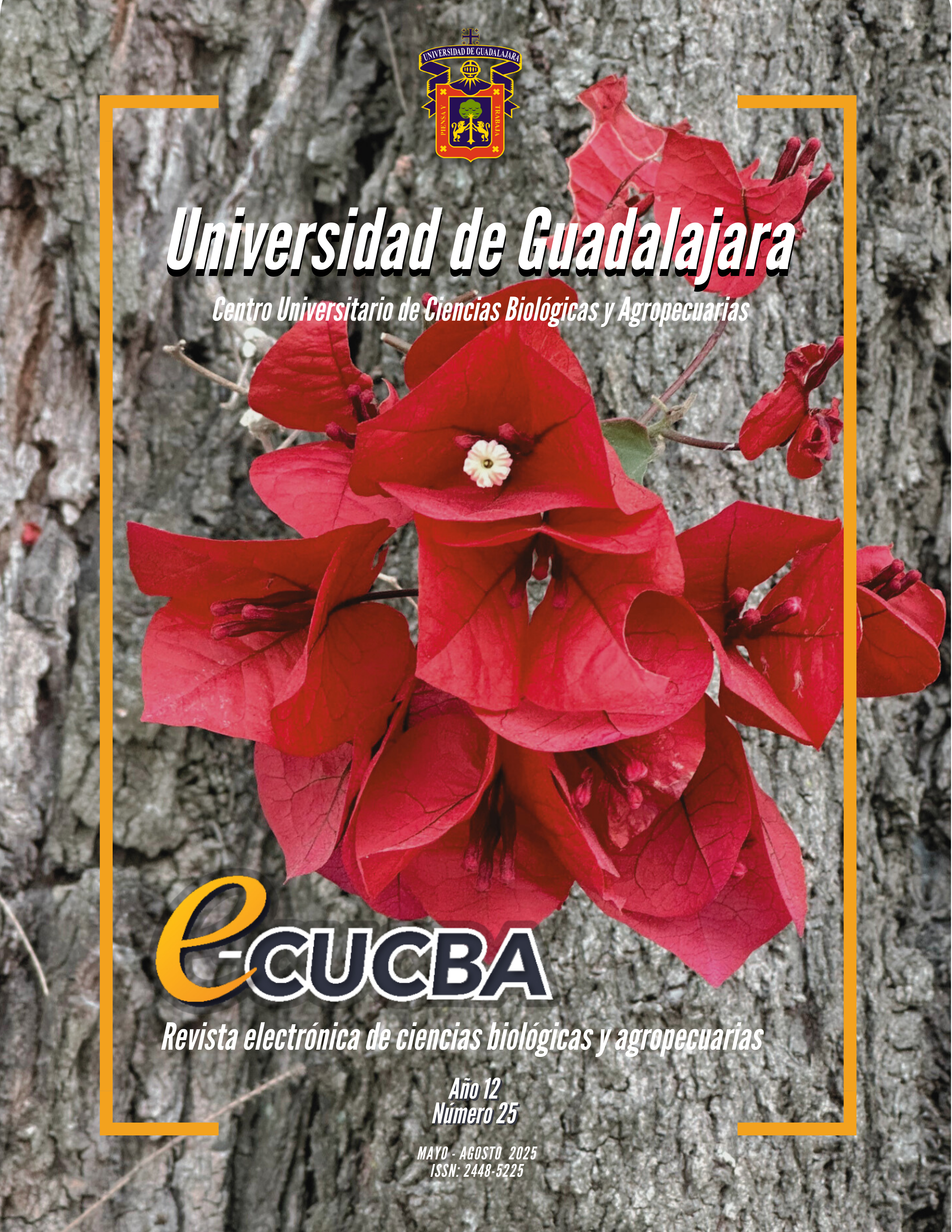Estado del clima en Jalisco: temporada de lluvias y comportamiento extremo de la temperatura en 2024
Climate Status in Jalisco: Rainy Season 2024 and Extreme Temperature Behavior in 2024
DOI:
https://doi.org/10.32870/e-cucba.vi25.382Keywords:
Precipitation, climate, Jalisco, climate variabilityAbstract
This article analyzes the characteristics of the rainy season and extreme temperatures recorded in the state of Jalisco, Mexico, during 2024. Using ERA5 reanalysis data, the CHIRPS product, and observations from thirteen weather stations, precipitation and temperature anomaly patterns were identified. The results show a late onset and an early conclusion of the rainy season, with positive anomalies in the central and southern regions and significant deficits along the coastal strip. Furthermore, 2024 was the warmest year on record, with an average anomaly of 2.3°C during May–October, surpassing the 2023 record. This warming probably is attributed to the combination of anthropogenic climate change and an El Niño event, altering local atmospheric patterns and affecting rainfall distribution. The findings highlight Jalisco's climate vulnerability, especially in the agricultural sector, which depends on stable climatic patterns. This study underscores the need to strengthen monitoring networks, implement predictive models, and design adaptation strategies to mitigate impacts on key sectors such as agriculture and water resources.
References
Anderson, W., Seager, R., Baethgen, W. y Cane, M. (2019). Transient Climate Impacts on Agroecosystems in Central and South America. Environmental Research Letters, 14(11), 114033. https://doi.org/10.1088/1748-9326/ab4912
Bravo Cabrera, J. L., Azpra Romero, E., Rodríguez González, F. J. y Rodríguez López, O. (2018). Los efectos del ENOS sobre la precipitación en la Ciudad de México. Investigaciones Geográficas, (96), 1-16. https://doi.org/10.14350/rig.59679
CPC-Climate Weather Linkage: Madden - Julian Oscillation. (s. f.). https://www.cpc.ncep.noaa.gov/products/precip/CWlink/MJO/mjo.shtml
Díaz-Fernández, J., Calvo-Sancho, C., Bolgiani, P., Sastre, M., López-Reyes, M., Fernández-González, S. y Martín, M. L. (2025). Effect of complex orography on numerical simulations of a downburst event in Spain. Atmospheric Research, 314, 107821. https://doi.org/10.1016/j.atmosres.2024.107821
Estrada-Porrúa, F. y Gay y García, C. (2015). Reporte Mexicano de Cambio Climático. Vol. 219, pp. 265-294.
FAO. (2016). Coping with water scarcity: An action framework for agriculture and food security. Food and Agriculture Organization of the United Nations. https://www.fao.org/3/i6459e/i6459e.pdf
Ferrari, L., López-Martínez, M., & Rosas-Elguera, J. (2012). Volcanic and tectonic evolution of the Trans-Mexican Volcanic Belt. Geology of Mexico. https://doi.org/10.18268/bsgm2005v57n3a2
García Concepción, O., Ramírez Sánchez, H. U., Alcalá Gutiérrez, J., Meulenert Peña, Á. y García Guadalupe, M. E. (2007). Climatología de las tormentas eléctricas locales severas (TELS) en la Zona Metropolitana de Guadalajara. Investigaciones geográficas, (63), 7-16.
INEGI (2013). Conociendo Jalisco. https://www.inegi.org.mx/contenido/productos/prod_serv/contenidos/espanol/bvinegi/productos/estudios/conociendo/JALISCO.pdf
INEGI (2020). Conjunto de datos vectoriales de uso del suelo y vegetación escala 1:250,000. https://www.inegi.org.mx/app/biblioteca/ficha.html?upc=889463173359
IPCC. (2021). Climate Change 2021: The Physical Science Basis. https://www.ipcc.ch/report/ar6/wg1/
IPCC. (2023). Climate Change 2023: Synthesis Report. https://www.ipcc.ch/report/ar6/syr/
León-Cruz, J. F., Caetano, E., Dominguez, C., Cortés-Ramos, J., Méndez-Pérez, J. M. y Jaramillo, A. (2024). Spatiotemporal Characterization of Instability Indices Associated with Thunderstorms in Mexico. Advances in Meteorology, 2024(1), 4478159. https://doi.org/10.1155/2024/4478159
Li, J. y Heap, A. D. (2014). Spatial interpolation methods applied in the environmental sciences: A review. Environmental Modelling & Software, 53, 173-189. https://doi.org/10.1016/j.envsoft.2013.12.008
Lobell, D. B., Schlenker, W. y Costa-Roberts, J. (2011). Climate trends and global crop production since 1980. Science, 333(6042), 616–620. https://doi.org/10.1126/science.1204531
Magaña, V., Amador, J. A. y Medina, S. (2003). The Midsummer Drought over Mexico and Central America. Journal of Climate, 16(9), 1573–1588. https://doi.org/10.1175/1520-0442(2003)016<1573:TMDOMA>2.0.CO;2
Magaña, V., Vázquez, J. L., Pérez, J. L. y Pérez, J. B. (2003). Impact of El Niño on precipitation in Mexico. Geofísica Internacional, 42(3), 313-330.
Maraun, D. (2013). Bias Correction, Quantile Mapping, and Downscaling: Revisiting the Inflation Issue. Journal of Climate, 26(6), 2137-2143. https://doi.org/10.1175/JCLI-D-12-00821.1
Méndez González, J., Ramírez Leyva, A., Cornejo Oviedo, E., Zárate Lupercio, A. y Cavazos Pérez, T. (2010). Teleconexiones de la Oscilación Decadal del Pacífico (PDO) a la precipitación y temperatura en México. Investigaciones Geográficas, (73), 5-20.
NHC NOAA. (2024). Tropical Storm ILEANA Advisory Archive. https://www.nhc.noaa.gov/archive/2024/ILEANA.shtml
NHC. (s. f.). Data in GIS Formats. https://www.nhc.noaa.gov/gis/
NOAA. (2013). Ciclones Tropicales. Guía de Prevención. https://www.weather.gov/media/owlie/ciclones_tropicales11.pdf
NOAA. (2024). Global climate report for 2024. https://www.noaa.gov
Nobel, P. S. (1994). Environmental Biology of Agaves and Cacti. Cambridge University Press.
Pavia, E. G., Graef, F. y Reyes, J. (2006). PDO-ENSO effects in the climate of Mexico. Journal of Climate, 19(24), 6433-6438.
Pérez-Dolores, A. (2023). Caracterización de la precipitación en el Área Metropolitana de Guadalajara 2016-2021. Tesis de Maestría. Universidad de Guadalajara.
Pimienta-Barrios, E., Zañudo-Hernández, J., Nobel, P. S. y Ruvalcaba-Ruiz, D. (2001). Growth and development of the cultivated agave (Agave tequilana) and the influence of environmental factors. Agricultural and Forest Meteorology, 107(1), 39-51. https://doi.org/10.1016/S0168-1923(00)00233-3
Quiroga, S., Suárez, C. y Solís, D. (2020). Climate Variability and Agricultural Productivity in Latin America. Climate Policy, 20(2), 240-255. https://doi.org/10.1080/14693062.2019.1658243
Rodríguez-Moreno, V. M., Ruíz-Corral, J. A., Medina-García, G., Padilla-Ramírez, J. S. y Kretzschmar, T. G. (2014). Efecto de la condición ENSO en la frecuencia e intensidad de los eventos de lluvia en la península de Baja California (1998-2012). Revista Mexicana de Ciencias Agrícolas, 5(10), 1923-1937. https://doi.org/10.29312/remexca.v5i10.1055
Ruiz-Sinoga, J. D. y Martínez-Murillo, J. F. (2009). Los procesos de desertificación en el sur de Europa: un enfoque geomorfológico. Boletín de la Asociación de Geógrafos Españoles, (51), 243-265.
Servicio Meteorológico Nacional. (2024). Inicio de la temporada lluviosa. https://smn.conagua.gob.mx
Ugalde, K., Alfaro, E. J., Hidalgo, H. G. y Maldonado, T. (2024). Caracterización climática de la lluvia del Pacífico Norte de Costa Rica usando análogos construidos. Revista Tecnología en Marcha, ág-3. https://doi.org/10.18845/tm.v37i4.6842
World Meteorological Organization. (2023). 2023 set to be one of the hottest years on record. https://public.wmo.int
Downloads
Published
How to Cite
Issue
Section
License
Copyright (c) 2025 Julio Eduardo Zamora-Salvador, Alma Delia Ortíz-Bañuelos, Stephany Paulina Arellano-Ramírez, Carlos Román-Castañeda, Armando González-Figueroa, Hector Hugo Ulloa-Godínez, Mario E. García Guadalupe, Mauricio López-Reyes

This work is licensed under a Creative Commons Attribution-NonCommercial-NoDerivatives 4.0 International License.






